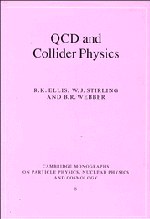Book contents
- Frontmatter
- Contents
- Preface
- 1 Fundamentals of QCD
- 2 Asymptotic freedom and confinement
- 3 QCD in electron-positron annihilation
- 4 Deep inelastic scattering
- 5 Parton branching and jet simulation
- 6 Jet properties beyond fixed order
- 7 Hadroproduction of jets and photons
- 8 Electroweak interactions
- 9 The production of vector bosons
- 10 Heavy quarks
- 11 Higgs bosons at high-energy colliders
- 12 Measurements of the strong coupling constant
- Index
8 - Electroweak interactions
Published online by Cambridge University Press: 05 May 2010
- Frontmatter
- Contents
- Preface
- 1 Fundamentals of QCD
- 2 Asymptotic freedom and confinement
- 3 QCD in electron-positron annihilation
- 4 Deep inelastic scattering
- 5 Parton branching and jet simulation
- 6 Jet properties beyond fixed order
- 7 Hadroproduction of jets and photons
- 8 Electroweak interactions
- 9 The production of vector bosons
- 10 Heavy quarks
- 11 Higgs bosons at high-energy colliders
- 12 Measurements of the strong coupling constant
- Index
Summary
Although the main topic of this book is the study of QCD, it is in practice impossible to ignore the electroweak interactions. From an experimental point of view they are inextricably linked with QCD. The success of the present day e+e− colliders in the study of QCD is due to the large event rates which occur at the Z boson resonance. In addition, many of the event signatures at hadronic colliders involve either the production of vector bosons or leptons coming from the weak decays of heavy quarks. This chapter describes the Standard Electroweak Model [1], which, together with the discovery of QCD, was the triumph of the 1960s and 1970s. The model provides a unified description of the weak and electromagnetic interactions in terms of a renormalizable, gauge invariant field theory. We shall present the Lagrangian of the model and the Feynman rules which follow from it, together with some consequences of the standard model couplings. A more complete treatment of the electroweak sector of the Standard Model can be found, for example, in ref. [2].
Gauge boson interactions
In QED the Lagrangian density has the property of local gauge invariance. The analogous property for QCD was explained in Section 1.3.
- Type
- Chapter
- Information
- QCD and Collider Physics , pp. 270 - 300Publisher: Cambridge University PressPrint publication year: 1996



